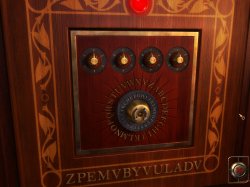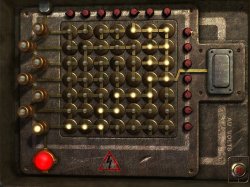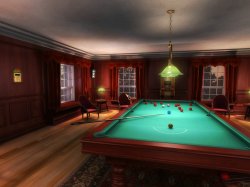|
Safecracker: The Ultimate Puzzle Adventure
 If you've been wondering, well yes, Safecracker: The Ultimate Puzzle Adventure, is quite a lot like the Safecracker puzzle game released back in 1997. But it isn't the same game.
It's similar in that you'll be exploring a palatial mansion and solving puzzles to unlock a series of safes and doors to find the ultimate prize, but the puzzles are different. They are mostly the same type of abstract puzzle with dial turning, button pressing and cipher decoding, but not the same puzzles. Some will surely be familiar, of course, but others I hadn't seen before, and there are some interesting variations too. Also the back story is different, the playing window is almost full screen as opposed to the relatively small window of the first Safecracker and, all importantly, there is no ticking clock on this occasion. In Safecracker: The Ultimate Puzzle Adventure you can relax, take your time, and soak up the puzzling.
The clock has been banished because this time you are not taking a test to demonstrate your safecracking prowess in order to land a new job. In this game you are now a recognised safecracker employed by the Adams family. Oil tycoon, Duncan W. Adams, has died and his family are seeking his will somewhere in the house. Duncan Adams was a safe fanatic and collector, so there are a lot of safes to crack before you reach the end. If you've been wondering, well yes, Safecracker: The Ultimate Puzzle Adventure, is quite a lot like the Safecracker puzzle game released back in 1997. But it isn't the same game.
It's similar in that you'll be exploring a palatial mansion and solving puzzles to unlock a series of safes and doors to find the ultimate prize, but the puzzles are different. They are mostly the same type of abstract puzzle with dial turning, button pressing and cipher decoding, but not the same puzzles. Some will surely be familiar, of course, but others I hadn't seen before, and there are some interesting variations too. Also the back story is different, the playing window is almost full screen as opposed to the relatively small window of the first Safecracker and, all importantly, there is no ticking clock on this occasion. In Safecracker: The Ultimate Puzzle Adventure you can relax, take your time, and soak up the puzzling.
The clock has been banished because this time you are not taking a test to demonstrate your safecracking prowess in order to land a new job. In this game you are now a recognised safecracker employed by the Adams family. Oil tycoon, Duncan W. Adams, has died and his family are seeking his will somewhere in the house. Duncan Adams was a safe fanatic and collector, so there are a lot of safes to crack before you reach the end.
 Safecracker: The Ultimate Puzzle Adventure is a first person perspective, mouse driven, puzzle game. You move around the Adams Mansion in step mode and at each location you can swing around and look in all directions by simply moving the cursor. The mouse pointer will turn into a magnifying glass when there is a puzzle to solve and there is a small hand icon for picking up objects.
It's a grand mansion with around 35 areas to explore including a winter garden, dining room, museum, library, games room, loft, kitchen, plus an assortment of bedrooms and bathrooms. There are 35 puzzles too, although they are not neatly allocated one to a room. Some rooms have more than one puzzle, some have none.
Of course, you don't have access to the whole mansion at the outset, you have to work to open the way. Sometimes electronic combination locks open doors so you must go searching for that magic number, sometimes keys will do the trick and they are probably locked away in a safe somewhere. Once you open a few doors though, there is a lot of house to explore. Just remember you don't need to solve each puzzle as you come to it, indeed it might not be possible, so look around and check if there is help elsewhere.
A map aids with exploration. As you open rooms they are added to the map. Each room is named and a red cross marks a puzzle. Solve the puzzle and the red cross turns green. The map with its puzzle markers is very useful for navigating around although it can't be used to jump from location to location. Safecracker: The Ultimate Puzzle Adventure is a first person perspective, mouse driven, puzzle game. You move around the Adams Mansion in step mode and at each location you can swing around and look in all directions by simply moving the cursor. The mouse pointer will turn into a magnifying glass when there is a puzzle to solve and there is a small hand icon for picking up objects.
It's a grand mansion with around 35 areas to explore including a winter garden, dining room, museum, library, games room, loft, kitchen, plus an assortment of bedrooms and bathrooms. There are 35 puzzles too, although they are not neatly allocated one to a room. Some rooms have more than one puzzle, some have none.
Of course, you don't have access to the whole mansion at the outset, you have to work to open the way. Sometimes electronic combination locks open doors so you must go searching for that magic number, sometimes keys will do the trick and they are probably locked away in a safe somewhere. Once you open a few doors though, there is a lot of house to explore. Just remember you don't need to solve each puzzle as you come to it, indeed it might not be possible, so look around and check if there is help elsewhere.
A map aids with exploration. As you open rooms they are added to the map. Each room is named and a red cross marks a puzzle. Solve the puzzle and the red cross turns green. The map with its puzzle markers is very useful for navigating around although it can't be used to jump from location to location.
 So what sort of puzzles to expect? There are simple codes to find, less simple codes to recognise or decipher, wheels with coloured balls to turn, and objects to find to replace missing components of a lock. There is a tile turning puzzle to make a picture (where have your seen that picture before), and various frames containing mazes where you find a particular pathway through by pressing buttons or, maybe, connect up points across a board by manipulating dials or pieces of the puzzle itself. One lock combination relies on billiard balls and a billiard table for the clue, and another relies on movement.
They are a varied bunch. Some are so simple that they might catch you out, others tease as you try to figure out the object of the exercise. Sometimes your character will comment and give you a clue to solve a puzzle, sometimes you are on your own. For the cipher puzzles I jumped on the clues and Googled to learn the methodology for the ciphers, they were fun. For another I looked absolutely everywhere for the clue only to eventually find it was staring me right in the face.
So some of the puzzles do make you think, experimentation helps in some cases as well. But with a little fiddling and/or careful observation they are never blindingly difficult unless you miss the obvious like I did. I suppose I was blind at the time. Of course there is bound to be one to send you climbing the wall, but there are a lot to make you feel good when you get it right. So what sort of puzzles to expect? There are simple codes to find, less simple codes to recognise or decipher, wheels with coloured balls to turn, and objects to find to replace missing components of a lock. There is a tile turning puzzle to make a picture (where have your seen that picture before), and various frames containing mazes where you find a particular pathway through by pressing buttons or, maybe, connect up points across a board by manipulating dials or pieces of the puzzle itself. One lock combination relies on billiard balls and a billiard table for the clue, and another relies on movement.
They are a varied bunch. Some are so simple that they might catch you out, others tease as you try to figure out the object of the exercise. Sometimes your character will comment and give you a clue to solve a puzzle, sometimes you are on your own. For the cipher puzzles I jumped on the clues and Googled to learn the methodology for the ciphers, they were fun. For another I looked absolutely everywhere for the clue only to eventually find it was staring me right in the face.
So some of the puzzles do make you think, experimentation helps in some cases as well. But with a little fiddling and/or careful observation they are never blindingly difficult unless you miss the obvious like I did. I suppose I was blind at the time. Of course there is bound to be one to send you climbing the wall, but there are a lot to make you feel good when you get it right.
Safecracker: The Ultimate Puzzle Adventure is a nice looking game. The graphics are excellent showing off the plush furnishings and fancy floor coverings of the Adams Mansion. The wooden floors in the upper hallways look so polished, and movement is smooth and slick. There is some light and occasional music to calm your nerves whilst working on the puzzles, or you might want to listen to your favourite music CD. I did. There are no game characters to meet so there is very little dialogue, just a comment or two from your good self, who will also read aloud the various letters and notes you find scattered around. All the dialogue is subtitled making Safecracker: The Ultimate Puzzle Adventure easily accessible for deaf or hard of hearing players. And a bonus here is that there are no aural puzzles.
In short, it's a most enjoyable and satisfying puzzle game that you can work through in a couple of sittings or, if you prefer, take a puzzle or two at a time and make it last longer. I would recommend it for any puzzle game fan. There are limitless saves as far as I could tell and provision for 5 players to open their own game and save separately. When you finally reach the end there's a little surprise in store. I'd like to mention briefly your final task, but it would give the game away!
Copyright © Rosemary Young 2006.
All rights reserved.
System Requirements:
Windows 98SE/ME/2000/XP (XP recommended), 800 MHz Pentium 3 or Athlon (1GHz P4 recommended), 64 MB RAM (128 MB recommended), 64 MB DirectX 9.0c Compliant video card, 16x Speed CD\DVD ROM (24x speed recommended), DirectX 9.0c Compatible sound card, 700 MB Available hard disk space, DirectX 9.0c (included), Mouse, keyboard, and speakers.
|

